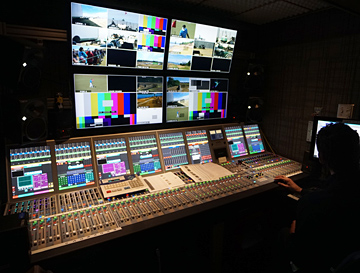Getting The Game On: U.S. Open

A Calrec Apollo digital audio console was the centerpiece in the Game Creek Video production truck used for the U.S. Open—one of several Calrec consoles deployed for the Fox Sports coverage of the event.
HUDSON, N.H.—Game Creek Video handles mobile television production for the world’s largest TV networks, production companies, and news organizations. We’ve earned a reputation for skillful coverage of sports and entertainment shows, which is why you’ll find our OB trucks and production teams in the truck compound for major events such as the Super Bowl, the World Series, NASCAR races and the FIS World Skiing Championship.
One of the biggest changes I have seen in sports coverage over the past 15 years is an increased emphasis on and commitment to audio by the broadcast networks. The networks have determined that the viewers’ audio experience is as important as the video. Audio has gone from being an afterthought to a key part of the production.
Fox Sports is one of the leaders in that charge. Last year, when covering the 2014 U.S. Open golf championship, we began planning with Fox Sports for coverage of the 2015 event. Game Creek would provide the ad hoc network at Chambers Bay golf course in Washington state, and Fox Sports would operate it. Fox is known for placing special importance on audio, particularly surround sound, because they understand the value of a high-quality audio production.
Brad Cheney, director of technical operations for Fox Sports, said it best: “We are out to capture the sounds of the course in an all-encompassing way, so we put equal emphasis on sound at every hole. It’s so important that we’ve even got additional audio engineers working in our ISO replay rooms to make sure the sounds are consistent on-air and online.”
Today’s productions place enormous demands on audio processing, and those demands would be multiplied for this event. We had to build a network to deal with 118 cameras, more than 200 microphones, and a massive number of line inputs. Audio would be coming in from a number of sources besides the microphones. For example, each replay device would have 16 channels of 5.1 audio. There would be audio associated with graphics. There would be primary and backup systems onsite.
There would also be 24 Calrec fieldboxes (small-format I/O units) sitting around the course, sending 5.1 audio to the trucks via fiber, providing a huge efficiency advantage. Not only would they save us from running DT-12 but fiber is lighter, less obtrusive, and can carry more signals than DT-12.
Get the TV Tech Newsletter
The professional video industry's #1 source for news, trends and product and tech information. Sign up below.
Fox would be producing content for its linear networks, Fox and Fox Sports1, along with complementary programming for usopen.com, usga.org and foxsports.com. In early talks, it was clear that capturing the sound Fox viewers have come to expect would require a large network of audio consoles and operators. Fox had already done its homework and determined that the only way to do it right was with Calrec consoles, specifically the Apollo.
Game Creek is an all-Calrec fleet. We built the network for Fox with four Apollo consoles, one Artemis console, and two Summa consoles, all inside of our production trucks. This would be the largest network we had ever created.
BIGGEST CHALLENGE

Calrec's Artemis console was used for the U.S. Open release mix.
The biggest challenge with a network of that size was tying all of the assets together and making them work with each other while giving the operators maximum flexibility. We had never attempted to tie five consoles together in a seamless package before. Without Calrec’s built-in Hydra2 technology we wouldn’t have been able to do it.
Fox operators mixed the broadcast with one Apollo desk and did the submix with another. They used the Artemis console for the release mix from the ISO replay rooms and mixed additional digital programming with an Apollo and two Summa consoles. While not on the network, SD10B consoles from Calrec’s sister company, DiGiCo, in the ISO production rooms, were connected via MADI to the main production truck to provide hole coverage via replay into both the main and digital programming.
The network meant Fox’s audio engineers could cover any part of the course at any moment with the full resources that are normally only available to the main show. The importance of this flexible networking capability cannot be overstated.
There were plenty of other benefits to using Calrec consoles. Over time, Calrec has expanded the number of audio sources its consoles can handle, in a way that’s efficient and instinctive for operators. That ensured that we could design a system that got the job done in the most efficient and least time-consuming way. And we knew the system would be robust and reliable—something we had to consider given the Pacific Northwest’s unpredictable June weather.
Another Calrec advantage is the company’s outstanding customer support. Their people are experts who not only helped us specify to configure the system but joined us in the field to help us set up the system to yield the best performance. That’s why Game Creek Video is a repeat customer.
The bottom line: Our business is all about making the customer happy. We know when we purchase Calrec equipment we’re going to get great reliability, great sound, great performance, great flexibility for the operator, and great service, so that ultimately we can help the customer create the very best production.
